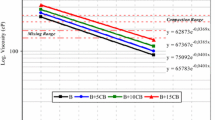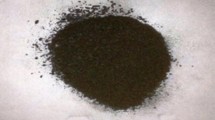Abstract
This work aims to characterize the rheological properties of lignin-modified bitumen. Various contents (0, 10, 20 and 30% by total mass of the modified bitumen) of Kraft lignin, which is derived from softwood and were used with two soft and unmodified bitumen adapted for cold climates and standard traffic level (PG 58S-28 and PG 52S-34). Storage stability test and microscope observations were performed to check the stability and homogeneity of the modified bitumen. Brookfield rotational viscometer (BRV), dynamic shear rheometer (DSR), multiple stress creep recovery (MSCR) and bending beam rheometer (BBR) tests were carried out to evaluate the thermomechanical behaviour and to determine the performance grade (PG Hn-L) of lignin-modified bitumens. Results indicate that the modified bitumen is homogeneous and no stability issues were observed. Also, results show that using Kraft lignin, as a bio-substitute to the bitumen, increased the viscosity (η), the stiffness (S) and the performance at high temperatures, but it made the bitumen more brittle and less performant at low temperatures. Notably, there is no significant change in the thermal range of use of bitumen (H–L), just a shift in performance grade (PG Hn-L) to higher temperatures. In addition, Kraft lignin has almost the same effects on both bitumen. To this end, the test results show that it is possible to use Kraft lignin to partially replace the bitumen.







Similar content being viewed by others
Data availability
The data is available upon request.
References
Gao, J., Wang, H., Liu, C., Ge, D., You, Z., & Yu, M. (2020). High-temperature rheological behaviour and fatigue performance of lignin modified asphalt binder. Construction and Building Materials, 230, 117063. https://doi.org/10.1016/j.conbuildmat.2019.117063
Al-Hadidy, A. I. (2023). Experimental investigation on performance of asphalt mixtures with waste materials. International Journal Pavement Research Technology. https://doi.org/10.1007/s42947-023-00288-w
Li, R., Bahadori, A., **n, J., Zhang, K., Muhunthan, B., & Zhang, J. (2020). Characteristics of bioepoxy based on waste cooking oil and lignin and its effects on asphalt binder. Construction and Building Materials, 251, 118926. https://doi.org/10.1016/j.conbuildmat.2020.118926
Watkins, D., Nuruddin, M., Hosur, M., Tcherbi-Narteh, A., & Jeelani, S. (2015). Extraction and characterization of lignin from different biomass resources. Journal of Materials Research and Technology, 4(1), 26–32. https://doi.org/10.1016/j.jmrt.2014.10.009
Kun, D., & Pukánszky, B. (2017). Polymer/lignin blends: Interactions, properties, applications. European Polymer Journal, 93, 618–641. https://doi.org/10.1016/j.eurpolymj.2017.04.035
**e, S., Li, Q., Karki, P., Zhou, F., & Yuan, J. S. (2017). Lignin as renewable and superior asphalt binder modifier. ACS Sustainable Chemistry & Engineering, 5(4), 2817–2823.
Gosselink R (2015) Lignin valorization towards materials, chemicals and energy. Proceedings, 2nd Lund symposium on lignin and hemicellulose valorisation, Lund
Boeriu, C. G., Gosselink, R. J. A., Frissen, A. E., Stoutjesdijk, J., & Peter, F. (2014). Fractionation of five technical lignins by selective extraction in green solvents and characterization of isolated fractions. Industrial Crops and Products, 62, 481–490.
Terrel, R. L., & Rimsritong, S. (1979). Wood lignins used as extenders for asphalt in bituminous pavements. Assoc Asphalt Paving Technol., 48, 111–134.
Batista, K. B., Padilha, R. P. L., Castro, T. O., Silva, C. F. S. C., Araújo, M. F. A. S., Leite, L. F. M., Pasa, V. M. D., & Lins, V. F. C. (2018). High-temperature, low-temperature and weathering aging performance of lignin modified asphalt binders. Industrial crops and products, 111, 107–116.
Norgbey, E., Huang, J., Hirsch, V., Liu, W. J., Wang, M., Ripke, O., Li, Y., Annan, G. E. T., Ewusi-Mensah, D., Wang, & Treib, G. (2020). Unravelling the efficient use of waste lignin as a bitumen modifier for sustainable roads. Construction and Building Materials, 230, 116957.
Wu, J., Liu, Q., Wang, C., Wu, W., & Han, W. (2021). Investigation of lignin as an alternative extender of bitumen for asphalt pavements. Journal of Cleaner Production, 283, 124663.
Ren, S., Liu, X., Zhang, Y., Lin, P., Apostolidis, P., Erkens, S., Li, M., & Xu, J. (2021). Multi-scale characterization of lignin modified bitumen using experimental and molecular dynamics simulation methods. Construction and Building Materials, 287, 123058.
Zhang, Y., Liu, X., Ren, S., **g, R., Lin, P., Apostolidis, P., Erkens, S., Wang, X., & Scarpas, A. (2022). Effect of bio-oil on rheology and chemistry of organosolv lignin-modified bitumen. Journal of Materials in Civil Engineering, 34(4), 1–16.
Fu X, He M, Liu Y (2021). Research on short-term aging of lignin modified asphalt. In E3S Web of Conferences (Vol. 233, p. 01125). EDP Sciences
Yu, J., Vaidya, M., Su, G., Adhikari, S., Korolev, E., & Shekhovtsova, S. (2021). Experimental study of soda lignin powder as an asphalt modifier for a sustainable pavement material. Construction and Building Materials, 298, 123884.
Arafat, S., Kumar, N., Wasiuddin, N. M., Owhe, E. O., & Lynam, J. G. (2019). Sustainable lignin to enhance asphalt binder oxidative aging properties and mix properties. Journal of cleaner production, 217, 456–468.
Fakhri, M., & Norouzi, M. A. (2022). Rheological and ageing properties of asphalt bio-binders containing lignin and waste engine oil. Construction and Building Materials, 321, 126364.
Xu, C., Wang, D., Zhang, S., Guo, E., Luo, H., Zhang, Z., & Yu, H. (2021). Effect of lignin modifier on engineering performance of bituminous binder and mixture. Polymers, 13(7), 1083.
Hobson, C. (2017). Evaluation of lignin as an antioxidant in asphalt binders and bituminous mixtures. Report FHWA-KS-16–17, Federal Highway Administration), Kansas. Dept. of Transportation, Bureau of Research.
Gaudenzi, E., Cardone, F., Lu, X., & Canestrari, F. (2023). The use of lignin for sustainable asphalt pavements: A literature review. Construction and Building Materials, 362, 129773.
Pérez, I. P., Rodríguez Pasandín, A. M., Pais, J. C., & Alves Pereira, P. A. (2019). Use of lignin biopolymer from industrial waste as bitumen extender for asphalt mixtures. Journal of Cleaner Production. https://doi.org/10.1016/j.jclepro.2019.02.082
Pérez, I., Pasandín, A. R., Pais, J. C., & Pereira, P. A. A. (2020). Feasibility of using a lignin-containing waste in asphalt binders. Waste and Biomass Valorization, 11(6), 3021–3034. https://doi.org/10.1007/s12649-019-00590-4
**e, J., Yang, Y., Lv, S., Peng, X., & Zhang, Y. (2019). Investigation on preparation process and storage stability of modified asphalt binder by grafting activated crumb rubber. Materials, 12(12), 2014.
ASTM D 92-18. (2018). Standard test method for flash and fire points by Cleveland Open Cup Tester. Washington: American Society for Testing and Materials.
LC 25-003. (2020). Test method for “Bitume – Stabilité au stockage”, Recueil des méthodes d’essais LC. Laboratoire des chaussées. Canada: Les Publications du Québec.
AASHTO T 316-19. (2019). Standard method of test for viscosity determination of bitumen using rotational viscometer. Washington: American Association of State Highway and Transportation Officials.
AASHTO T 315-12. (2012). Standard method of test for determining the rheological properties of asphalt binder using a dynamic shear rheometer (DSR). Washington: American Association of State Highway and Transportation Officials.
ASTM D 7643-16. (2016). Standard practice for determining the continuous grading temperatures and continuous grades for PG graded asphalt binders. Washington: American Society for Testing and Materials.
AASHTO T 240-13. (2013). Standard method of test for effect of heat and air on a moving film of asphalt binder (Rolling Thin-Film Oven Test). Washington: American Association of State Highway and Transportation Officials.
AASHTO T 350-14. (2014). Standard method of test for multiple stress creep recovery (MSCR) test of asphalt binder using a dynamic shear rheometer (DSR). Washington: American Association of State Highway and Transportation Officials.
AASHTO T 313-19. (2019). Standard method of test for determining the flexural creep stiffness of asphalt binder using the bending beam rheometer (BBR). Washington: American Association of State Highway and Transportation Officials.
Zhang, Y., Liu, X., Apostolidis, P., Gard, W., van de Ven, M., Erkens, S., & **g, R. (2019). Chemical and rheological evaluation of aged lignin-modified bitumen. Materials, 12(24), 4176.
Zahedi, M., Zarei, A., & Zarei, M. (2020). The effect of lignin on mechanical and dynamical properties of asphalt mixtures. SN Applied Sciences, 2(7), 1–10.
Xu, G., Wang, H., & Zhu, H. (2017). Rheological properties and anti-aging performance of asphalt binder modified with wood lignin. Construction and Building Materials, 151, 801–808.
ASTM D 5892-96a. (1996). Standard specification for type IV polymer-modified asphalt cement for use in pavement construction. Washington: American Society for Testing and Materials.
LC 25-007. (2020). Test method for “Bitume—Évaluation de la température associée à une viscosité”, Recueil des méthodes d’essais LC. Laboratoire des chaussées. Canada: Les Publications du Québec.
TQ 4101. (2020). Standard for “Bitumes.” Transports du Québec. Canada: Les Publications du Québec.
AASHTO M 332-21. (2021). Standard specification for performance-graded asphalt binder using multiple stress creep recovery (MSCR) test. Washington: American Association of State Highway and Transportation Officials.
AASHTO R 28-12. (2012). Standard practice for accelerated aging of asphalt binder using a pressurized aging vessel (PAV). Washington: American Association of State Highway and Transportation Officials.
ASTM C 670-03. (2003). Preparing precision and bias statements for test methods for construction materials. Belgium: American Society for Testing and Materials.
Zhang, G., Zhang, H., Bu, X., & Yang, H. (2018). Laboratory study on performances of bimaleimide/unsaturated polyester resin modified asphalt. Construction and Building Materials, 179, 576–586.
Vila-Cortavitarte, M., Lastra-González, P., Calzada-Pérez, M. Á., & Indacoechea-Vega, I. (2018). Analysis of the influence of using recycled polystyrene as a substitute for bitumen in the behaviour of asphalt concrete mixtures. Journal of Cleaner Production, 170, 1279–1287.
Rubio, M. C., Martínez, G., Baena, L., & Moreno, F. (2012). Warm mix asphalt: An overview. Journal of Cleaner Production, 24, 76–84.
Al-Qadi, I. L., Wang, H., Baek, J., Leng, Z., Doyen, M., & Gillen, S. (2012). Effects of curing time and reheating on performance of warm stone-matrix asphalt. Journal of Materials in Civil Engineering, 24(11), 1422–1428.
Cardone, F., Frigio, F., Ferrotti, G., & Canestrari, F. (2015). Influence of mineral fillers on the rheological response of polymer-modified bitumens and mastics. Journal of traffic and transportation engineering (English edition), 2(6), 373–381.
Badeli S, Bilodeau F, Carter A, Perraton, D (2018) Comparison of Thermal Stress Restrained Specimen Test (TSRST) Results with Bending Beam Rheometer (BBR) Results to Evaluate the Thermal Cracking Properties of Bituminous Materials. ISAP 2018 Conference, Fortaleza, Brazil
Kuity, A., Jayaprakasan, S., & Das, A. (2014). Laboratory investigation on volume proportioning scheme of mineral fillers in asphalt mixture. Construction and Building Materials, 68, 637–643.
Uzun, İ, & Terzi, S. (2012). Evaluation of andesite waste as mineral filler in asphaltic concrete mixture. Construction and Building Materials, 31, 284–288.
Barra, B., Momm, L., Guerrero, Y., & Bernucci, L. (2014). Characterization of granite and limestone powders for use as fillers in bituminous mastics dosage. Anais da Academia Brasileira de Ciências, 86, 995–1002.
Kütük-Sert, T., & Kütük, S. (2013). Physical and Marshall properties of borogypsum used as filler aggregate in asphalt concrete. Journal of Materials in Civil Engineering, 25(2), 266–273.
Chen, M. Z., Lin, J. T., Wu, S. P., & Liu, C. H. (2011). Utilization of recycled brick powder as alternative filler in asphalt mixture. Construction and Building Materials, 25(4), 1532–1536.
Lamothe S, Carret J-C, Al-Falahat W, Carter A (2022) Field Trial Sections of Kraft Lignin-Modified Hot Mix Asphalt. In 67th annual conference of Canadian Technical Asphalt Association (CTAA), Nov. 6–9, 2022, Kelowna, British Columbia
Funding
This project was funded by FPInnovations.
Author information
Authors and Affiliations
Contributions
WA: lab testing, analysis and writing. SL: review and editing. JCC: review and editing. AC: final review and editing.
Corresponding author
Ethics declarations
Conflict of Interest
No conflict of interests among the authors.
Rights and permissions
Springer Nature or its licensor (e.g. a society or other partner) holds exclusive rights to this article under a publishing agreement with the author(s) or other rightsholder(s); author self-archiving of the accepted manuscript version of this article is solely governed by the terms of such publishing agreement and applicable law.
About this article
Cite this article
Al-falahat, W., Lamothe, S., Carret, JC. et al. Effects of Kraft Lignin on the Performance Grade of Two Bitumens Used for Cold Climate. Int. J. Pavement Res. Technol. (2023). https://doi.org/10.1007/s42947-023-00302-1
Received:
Revised:
Accepted:
Published:
DOI: https://doi.org/10.1007/s42947-023-00302-1




